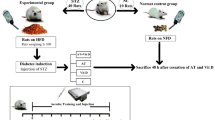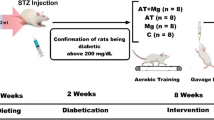Abstract
This study investigated the effect of exercise training on insulin resistance and serum and adipose TNF-α in high-fat diet-induced insulin-resistant rats. Thirty male Wistar rats were randomly divided into two groups: normal control group (NC; n = 8) that accepted normal chow and high-fat diet group (HF; n = 22) that fed on high-fat diet to induce insulin resistance model. The HF group was randomly assigned to two subgroups after 18 weeks: sedentary group (SE; n = 10) and exercise training group (ET; n = 12) that performed swimming exercise training for 6 weeks, while both groups continued high-fat diet. Changes of body weight, lipid profile, and fasting plasma glucose and insulin were measured. The insulin sensitivity index (ISI) was calculated. Serum concentration of TNF-α was detected by ELISA. The expression of TNF-α mRNA and protein in adipose tissue was examined by using real-time fluorescence quantitative polymerase chain reaction (PCR) and Western blot, respectively. After 18 weeks, compared with the NC group, body weight, blood lipid, glucose, and insulin in the HF group were significantly elevated, while the ISI decreased obviously, which suggested that insulin resistance appeared in the HF group. After exercise training for 6 weeks, compared with the SE group, both ISI and serum TNF-α concentration in the ET group were decreased significantly; however, the expression levels of TNF-α mRNA and protein in adipose tissue increased by 27.5% and 20.5%, respectively. In conclusion, exercise training ameliorates insulin resistance. The reduction of the level of serum TNF-α and the increased expression of TNF-α in adipose tissue by exercise training may be involved in this mechanism.
Similar content being viewed by others
References
Muoio D M, Newgard C B. Mechanisms of disease: molecular and metabolic mechanisms of insulin resistance and beta-cell failure in type 2 diabetes. Nat Rev Mol Cell Biol, 2008, 9(3): 193–205
Lebovitz H E. Insulin resistance—a common link between type 2 diabetes and cardiovascular disease. Diabetes Obes Metab, 2006, 8(3): 237–249
Corpeleijn E, Saris W H, Blaak E E. Metabolic flexibility in the development of insulin resistance and type 2 diabetes: effects of lifestyle. Obes Rev, 2009, 10(2): 178–193
Brestoff J R, Clippinger B, Spinella T, von Duvillard S P, Nindl B C, Arciero P J. An acute bout of endurance exercise but not sprint interval exercise enhances insulin sensitivity. Appl Physiol Nutr Metab, 2009, 34(1): 25–32
Guilherme A, Virbasius J V, Puri V, Czech M P. Adipocyte dysfunctions linking obesity to insulin resistance and type 2 diabetes. Nat Rev Mol Cell Biol, 2008, 9(5): 367–377
Waki H, Tontonoz P. Endocrine functions of adipose tissue. Annu Rev Pathol, 2007, 2: 31–56
Greenfield J R, Campbell L V. Relationship between inflammation, insulin resistance and type 2 diabetes: ‘cause or effect’? Curr Diabetes Rev, 2006, 2(2): 195–211
Wolf G. Role of fatty acids in the development of insulin resistance and type 2 diabetes mellitus. Nutr Rev, 2008, 66(10): 597–600
Smith U. Impaired (’diabetic’) insulin signaling and action occur in fat cells long before glucose intolerance is insulin resistance initiated in the adipose tissue? Int J Obes Retat Metab Disord, 2002, 26(7): 897–904
Rabe K, Lehrke M, Parhofer K G, Broedl U C. Adipokines and insulin resistance. Mol Med, 2008, 14(11,12): 741–751
Nieto-Vazquez I, Fernández-Veledo S, Krämer DK, Vila-Bedmar R, Garcia-Guerra L, Lorenzo M. Insulin resistance associated to obesity: the link TNF-alpha. Arch Physiol Biochem, 2008, 114(3): 183–194
Ploug T, Stallknecht B M, Pedersen O, Kahn B B, Ohkuwa T, Vinten J, Galbo H. Effect of endurance training on glucose transport capacity and glucose transporter expression in rat skeletal muscle. Am J Physiol, 1990, 259(6 Pt 1): 778–786
Gwozdziewiczová S, Lichnovská R, Ben Yahia R, Chlup R, Hrebícek J. TNF-alpha in the development of insulin resistance and other disorders in metabolic syndrome. Biomed Pap Med Fac Univ Palacky Olomouc Czech Repub, 2005, 149(1): 109–117
De Taeye B M, Novitskaya T, McGuinness O P, Gleaves L, Medda M, Covington J W, Vaughan D E. Macrophage TNF-alpha contributes to insulin resistance and hepatic steatosis in diet-induced obesity. Am J Physiol Endocrinol Metab, 2007, 293(3): 713–725
Vieira V J, Valentine R J, Wilund K R, Antao N, Baynard T, Woods J A. Effects of exercise and low-fat diet on adipose tissue inflammation and metabolic complications in obese mice. Am J Physiol Endocrinol Metab, 2009, 296(5): E1164–E1171
Gray S R, Baker G, Wright A, Fitzsimons C F, Mutrie N, Nimmo MA; Scottish Physical Activity Research Collaboration. The effect of a 12 week walking intervention on markers of insulin resistance and systemic inflammation. Prev Med, 2009, 48(1): 39–44
You T, Nicklas B J, Ding J, Penninx B W, Goodpaster B H, Bauer D C, Tylavsky F A, Harris T B, Kritchevsky S B. The metabolic syndrome is associated with circulating adipokines in older adults across a wide range of adiposity. J Gerontol A Biol Sci Med Sci, 2008, 63(4): 414–419
Wilding J P. The importance of free fatty acids in the development of Type 2 diabetes. Diabetes Med, 2007, 24(9): 934–945
Kaddai V, Jager J, Gonzalez T, Najem-Lendom R, Bonnafous S, Tran A, Le Marchand-Brustel Y, Gual P, Tanti J F, Cormont M. Involvement of TNF-alpha in abnormal adipocyte and muscle sortilin expression in obese mice and humans. Diabetologia, 2009, 52(5): 932–940
Lira F S, Rosa J C, Yamashita A S, Koyama C H, Batista M L Jr, Seelaender M. Endurance training induces depot-specific changes in IL-10/TNF-alpha ratio in rat adipose tissue. Cytokine, 2009, 45(2): 80–85
DeFuria J, Bennett G, Strissel K J, Perfield J W 2nd, Milbury P E, Greenberg A S, Obin M S. Dietary blueberry attenuates whole-body insulin resistance in high fat-fed mice by reducing adipocyte death and its inflammatory sequelae. J Nutr, 2009, 139(8): 1510–1516
Teixeira de Lemos E, Reis F, Baptista S, Pinto R, Sepodes B, Vala H, Rocha-Pereira P, Correia da Silva G, Teixeira N, Silva A S, Carvalho L, Teixeira F, Das U N. Exercise training decreases proinflammatory profile in Zucker diabetic (type 2) fatty rats. Nutrition, 2009, 25(3): 330–339
Liang H, Yin B, Zhang H, Zhang S, Zeng Q, Wang J, Jiang X, Yuan L, Wang C Y, Li Z. Blockade of tumor necrosis factor (TNF) receptor type 1-mediated TNF-alpha signaling protected Wistar rats from diet-induced obesity and insulin resistance. Endocrinology, 2008, 149(6): 2943–2951
Röckl K S, Brandauer J, Jessen N, Toyoda T, Nayer A, Hirshman M F, Goodyear L J. Effects of exercise training on subcutaneous and visceral adipose tissue in normal and high fat diet fed rats. Am J Physiol Endocrinol Metab, 2009 Jun 2, Epub ahead of print
Timmerman K L, Flynn M G, Coen P M, Markofski M M, Pence B D. Exercise training-induced lowering of inflammatory (CD14+CD16+) monocytes: a role in the anti-inflammatory influence of exercise? J Leukoc Biol, 2008, 84(5): 1271–1278
Sakurai T, Izawa T, Kizaki T, Ogasawara J E, Shirato K, Imaizumi K, Takahashi K, Ishida H, Ohno H. Exercise training decreases expression of inflammation-related adipokines through reduction of oxidative stress in rat white adipose tissue. Biochem Biophys Res Commun, 2009, 379(2): 605–609
Rubin D A, McMurray R G, Harrell J S, Hackney A C, Thorpe D E, Haqq A M. The association between insulin resistance and cytokines in adolescents: the role of weight status and exercise. Metabolism, 2008, 57(5): 683–690
Olszanecka-Glinianowicz M, Zahorska-Markiewicz B, Kocełak P, Janowska J, Semik-Grabarczyk E. The effect of weight loss on inflammation in obese women with polycystic ovary syndrome. Endokrynol Pol, 2008, 59(1): 13–17
Bradley R L, Jeon J Y, Liu F F, Maratos-Flier E. Voluntary exercise improves insulin sensitivity and adipose tissue inflammation in diet-induced obese mice. Am J Physiol Endocrinol Metab, 2008, 295(3): E586–E594
Author information
Authors and Affiliations
Corresponding author
Rights and permissions
About this article
Cite this article
Sun, H., Deng, X., Xiao, F. et al. Role of exercise training on insulin resistance and TNF-α in high-fat diet rats. Front. Med. China 3, 403–407 (2009). https://doi.org/10.1007/s11684-009-0071-0
Received:
Accepted:
Published:
Issue Date:
DOI: https://doi.org/10.1007/s11684-009-0071-0




